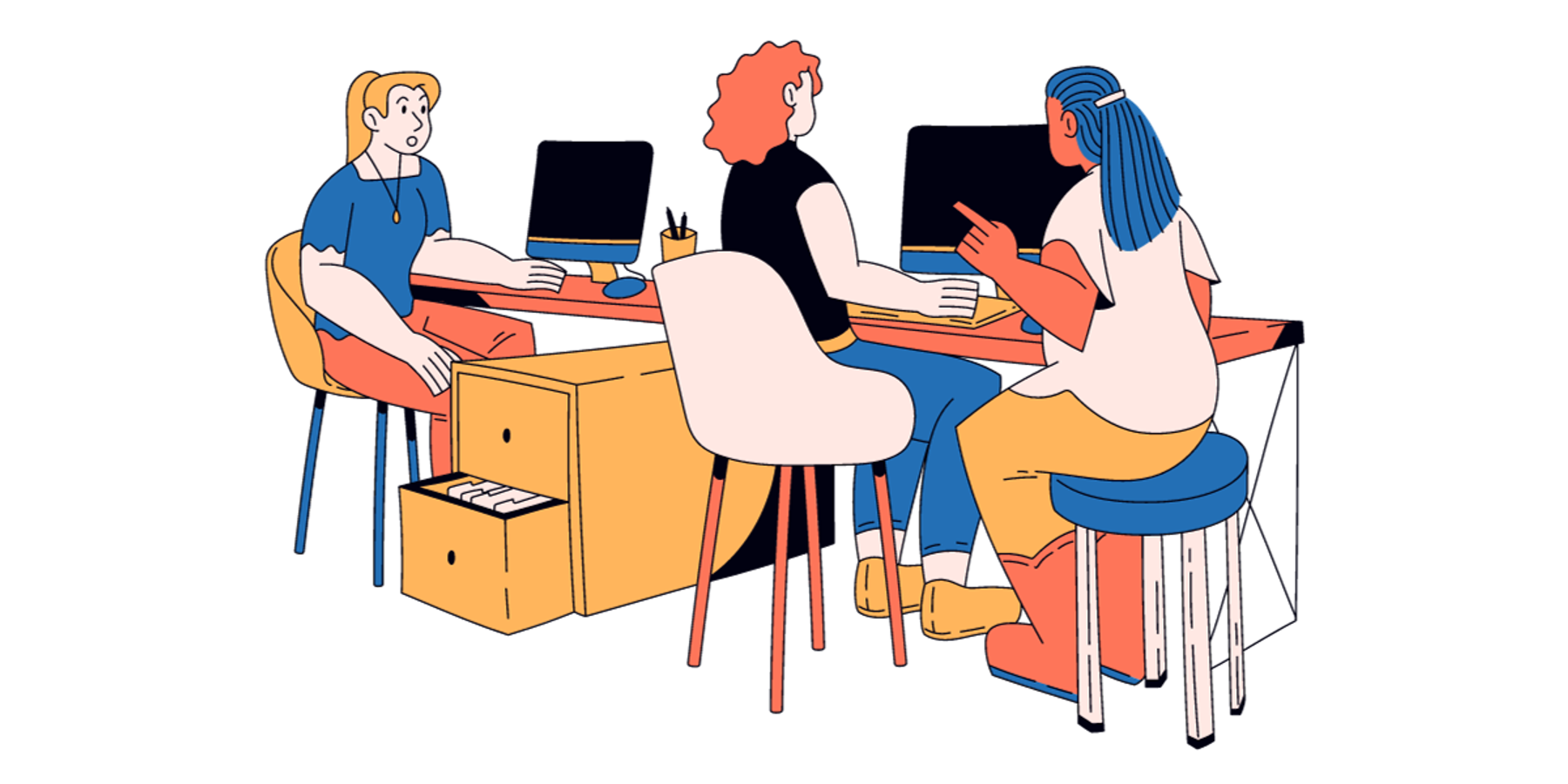If you're ready to learn more about diversity, equity, inclusion, and belonging (DEIB) language, read on as we cover BIPOC, a term that’s become much more well-known and commonly used since 2020. We'll answer questions like: "What does BIPOC stand for?" "Are Asians and Latinos BIPOC?" and "BIPOC vs POC — which should I use?" Inclusive language, much like DEIB itself, is always evolving.
As always, our goal with this explainer is to empower you to lead and participate in efforts to make your own workplace inclusive and supportive of all talent, including for folks who identify as BIPOC. To achieve that, read on for the definitions and context you’ll need to get started, including a breakdown of BIPOC’s origin and when to use (and not use) the term.
BIPOC meaning and definition
BIPOC is an acronym. It stands for Black, Indigenous, and people of color.
Black:
“Black” is a term that broadly refers to individuals with ancestral origins in any of Africa’s darker-complected racial groups. Blackness is as much about shared identity, experience, and culture as it is about any physical characteristic like skin color (which, for Black folks, exists across a range of skin tones). While the African diaspora, and therefore the existence of Black identity, is global, in the U.S., the term “African American” is frequently used to refer to this group. That said, there are many within this group who feel disconnected from or outright don’t identify with that term. That’s why it’s best to use Black as the default — never styling as “Blacks” — and use African American if that preference is stated.
Indigenous:
This term refers to individuals and the descendants of individuals who first lived in a given geographical region before people of different origins arrived and/or colonized that place. In the U.S., “Native Americans” is one of multiple terms used interchangeably with “Indigenous Peoples.” In Canada, the terms “Aboriginal Peoples” or “First Nations” are also used, while in Australia, “Aboriginal Australians” is commonly used. These terms are all broad and imprecise, and as with other DEIB best practices, specificity — including in naming specific Nations — is ideal whenever possible.
People of color (PoC):
People of color is a broad term for non-White people; it includes Black and Indigenous people but also may include those of Asian, Middle Eastern, Pacific Islander, or Latin American descent. The phrase can be polarizing, for those who identify this way and for folks who are identified this way. Many are in vocal support of the unity it signals, while others advocate that imprecise language like this erases many identities while centering Whiteness (more on that below).
The New Yorker described the origin of the term this way: “The phrase ‘people of color’ finds its origins in the eighteenth-century ‘gens de couleur,’ a French designation for mixed-race colonial subjects, and its permutation has been used in South Africa to name multiracial identities of all kinds (‘coloureds’). In the twentieth-century United States, ‘colored people’ was both a synonym for Black and, famously in the Third World Liberation Front of the late nineteen-sixties Bay Area, a postcolonial umbrella. At a national women’s conference in 1977, according to the anti-capitalist, feminist organizer Loretta Ross, ‘women of color’ was negotiated as a ‘solidarity definition,’ not a biological one, when women who were neither Black nor white asked to be included in a ‘Black women’s agenda.’ ‘People of color’ was subsequently popularized as a more radical, but also more mannerly, substitute for ‘minority.’”
Related reading: Diversity and Inclusion Acronyms: A 2023 Glossary
BIPOC pronunciation
When using the term BIPOC, don’t pronounce each letter separately (like B-I-P-O-C) even though this is how “PoC” on its own is pronounced (P-O-C). Instead, pronounce BIPOC as one word, which sounds phonetically like “buy pock” (pock as in “pocket”).
BIPOC vs POC
BIPOC builds on (and in some contexts, replaces) another popular DEIB acronym, PoC, while specifically highlighting the unique discrimination faced by Black and Indigenous groups. In the U.S., both of these groups have been subjected to genocide and enslavement, as well as to ongoing racist systems, language, practices, and behavior that lead to less wealth, poorer health, and shorter lifespans. In other words, for Black people, the repercussions of slavery didn’t end on June 19th, 1865, or when segregation was outlawed. For Indigenous people in the Americas, the impact of ethnic genocide and forced relocation didn’t end when the last assimilation-focused boarding schools for Indigenous children closed (which, by the way, wasn’t until the 1960s). The term BIPOC is meant to recognize that, while racism impacts all non-White groups, Black and Indigenous people have faced and continue to face unique and specific harm in the U.S.
Although the term was first used in 2013, it didn’t truly take off until May 2020 when protests against anti-Black police brutality exploded after the murder of George Floyd. There was some initial confusion over what the term actually means, with some people reading it as "bisexual people of color" or "Black and Indigenous people of color" — that is, a combination of Black and Indigenous people specifically versus a broader category that includes other non-White people, too.
It's now well-understood to mean Black, Indigenous, and people of color, and while the intention behind the term is to be extra inclusive — which is why you'll see it used in DEIB spaces — it’s also important to note that not everyone sees it that way.
From a September 2020 episode of NPR's Code Switch podcast: "I feel that the term PoC is nonsense, and I think it's a way for non-Black people to sit comfortably in their anti-Blackness because they're so afraid to say Black," says Christine Harris. "So they come up with these terms that make them feel comfortable with their Whiteness or their adjacency to Whiteness. And I get irritated — not irritated, vexed — when people refer to me as PoC or BIPOC. Like, no, absolutely not. I'm Black, don't play me."
Are Asians BIPOC? Are Latinos BIPOC?
For people of Asian and Pacific Islander (AAPI) descent, the answer is yes. Since PoC includes all non-White people, and Asians, Asian Americans, and Pacific Islanders are non-White, BIPOC includes them.
For Latino people, the answer is: sometimes. Remember that the term Latino refers to geography, meaning people residing in or with ancestors from Latin America. (The related term Hispanic describes anyone descended from Spanish-speaking populations.) Neither refers to race, which in and of itself is a social construct and not a biological classification. Therefore, a Black or Indigenous Latino might identify as a person of color whereas a White Latino might not.
The relationship between Latino people and race is a complicated one, particularly in the U.S., where people who look non-White (including Latino people with darker skin tones) or have Hispanic-sounding names may face discriminatory treatment more similar to the ways that Black and Indigenous groups are treated than the ways White people are treated. So in that way, Latino people as a group are most often considered to be included under the banner of PoC.
Regardless of whether the terms BIPOC and PoC are meant to include AAPI and Latino people, note that there are some who reject these acronyms for alluding to without naming these groups. Recognizing the validity of highlighting Black and Indigenous folks’ historic and contemporary struggles, Massachusetts College of Liberal Arts’ Chief Diversity Officer and Andrea Plaid, author of “Penning with the People,” still wrote: “If Audre Lorde famously said that there is no hierarchy of oppression, the term BIPOC sets up just such a hierarchy… BIPOC sets up an ‘us vs. them’ binary. The acronym for Black and Indigenous shifts Asian/Pacific Islander Americans and Latino Americans ‘over there,’ reinforcing the idea of inter-racial conflict rather than interracial solidarity.”
To avoid erasure of any group, we recommend, as always, to name the specific group or groups of people you’re talking about whenever possible. We’ll explain that further below, as well as walk through other use cases of when to use (and not use) the BIPOC and PoC acronyms.
When to use BIPOC vs POC
Both BIPOC or POC could be used as acronyms for people who are not White; for example, when referring to BIPOC musicians or PoC scholars (although you can always get more specific, and should whenever possible). However, like much of what we talk about when we talk about inclusive terminology, choosing to use the term BIPOC really comes down to respecting the preferences of the people you're referring to. For instance, some people may prefer to be called Black and others might like African American better. One person may identify as Native American and another as Indigenous and still another as a member of a specific tribe, finding umbrella terms like Native American to strip away the history of their tribe. If you don't know, listen to how your coworkers or employees refer to themselves or ask them outright what they'd prefer.When not to use BIPOC or POC
Pay attention to whether you're using umbrella terms like POC or BIPOC to avoid addressing the specific experiences of one underrepresented group. For instance, while using the term BIPOC might be a good way to talk about the broad non-White experience, BIPOC isn't a substitute for Black people. So, say who you mean. Don't accidentally erase a specific group's history, issues, and perspective if you mean to highlight them. When in doubt, ask the group you're trying to include what kind of terminology or behavior would make them feel included. You don't have to have all the answers — you just have to make space for the people who do.
Want to keep learning? Download our complete (free!) inclusive language guide.




